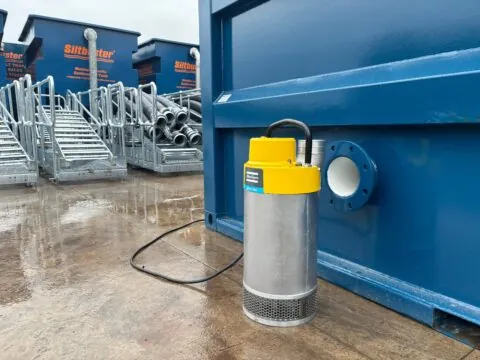Aluminium pump proves ideal for pH level adjustment

When fluid circulation specialist Trebles heard that Siltbuster, a water treatment solutions provider, wanted to utilise a submersible pump and experiment with pH level correction in water, it swiftly offered an Atlas Copco WEDA D50 to aid in the experimental setup, as Flow magazine found out.
Siltbuster is a leading provider of environmental solutions for responsive water and wastewater treatment. The company sought to develop an extremely efficient method for introducing gas into water through a pH correction system.
By equipping Siltbuster with a WEDA D50 Submersible pump, a solution has been devised to adjust the pH level in water. This approach entails attaching a Venturi system to the pump’s discharge, facilitating the injection of CO2 vapours into the water.
The WEDA D50’s lightweight aluminium construction, weighing approximately 55kg, as opposed to its cast iron counterpart weighing 70kg or more, significantly aids with the transportation of the pump, making handling much easier.
pH Correction System
When Trebles initially had a discussion with Siltbuster, the company wanted to develop a highly efficient method for gas transfer into the water to ultimately optimise wastewater treatment processes by correcting pH levels.
“The pump is of really high quality; one of the first things we do when we receive a pump is check the weight of the unit. If it’s got good weight and gravity, it obviously has a decent amount of metal in it. The next thing is that we literally tap the side of the pump to ensure there are no hollow spots inside it or that it’s got a good thick casting on it. So, my initial impression was that the stator housing is obviously a decent thickness because it doesn’t sound hollow,” explained Chris Lawless, Siltbuster’s Operations Technical Engineer.
The devised solution involves a sophisticated approach to pH level correction in wastewater treatment processes. By connecting a Venturi system to the discharge of the WEDA D50 pump, the methodology enables precise injection of CO2 vapours into the water. This innovative technique aims to achieve the desired results in adjusting pH levels, thereby improving the overall efficiency of water treatment operations.
“The predominant application is a gas saturation process. To correct the pH of alkaline water, we’ll be adding CO2 vapour. I’m actually going to add a Venturi system to the discharge of this pump to inject CO2. This pump will be submerged inside a tank, so it’s going to be an extremely efficient way of transferring gas into water and correcting the pH. So, this is ultimately going to be a pH correction system,” added Chris.
A notable advantage of the chosen solution lies in its lightweight aluminium construction, weighing approximately 55kg. This marks a significant difference from the conventional cast-iron equivalents, which typically surpass 70kg in weight. The substantial weight reduction not only enhanced operational manoeuvrability but also simplified the transportation of the pump, thereby streamlining logistical processes.
Throughout testing, Siltbuster discovered several pointers for optimising the pump’s performance. One notable observation was the importance of clear labelling regarding Direct-On-Line (DOL) operation on the pump casing to prevent damage to internal electronics, particularly when powered by an inverter. Additionally, it was noted that threaded aluminium connections could experience galling and seizing when attached to galvanised flanges. To prevent this, it is recommended that anti-seize be applied to all aluminium threads before attachment to dissimilar metals.
Additionally, users expressed a desire for a central lifting eye to attach a ‘D’ shackle to the handle to aid in manoeuvrability, and they would recommend exploring the availability of an anode kit for marine environments.
One feature noted by Siltbuster was the use of yellow paint, which notably enhanced the pump’s visibility once it was submerged. This helped to improve safety and allows for easy monitoring during operations. The integration of an overload and rotation relay system also proved highly beneficial. This feature minimises the need for service calls due to issues such as incorrect running or overcurrent, especially when wired DOL. Ultimately, it ensures smoother operation, reduces maintenance requirements and contributes to the overall efficiency and reliability of water treatment processes.
The teamwork between Trebles and Siltbuster demonstrates a shared dedication to pushing the limits of water treatment technologies. Through partnership, creative approaches, and a strong focus on environmental responsibility, this project highlights how it is possible to pave the way for new solutions in water treatment.







